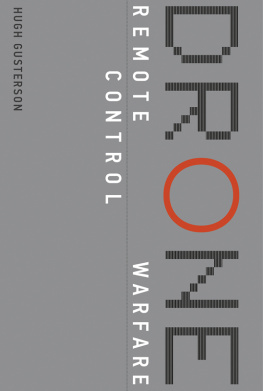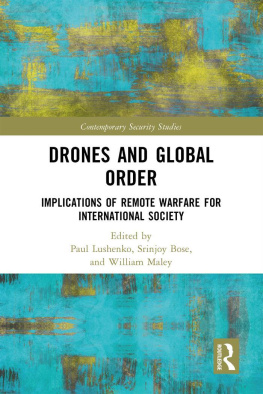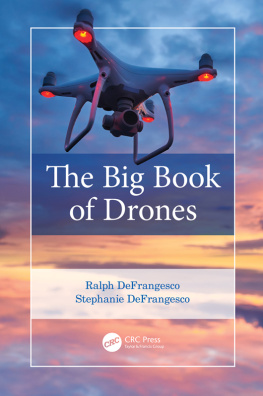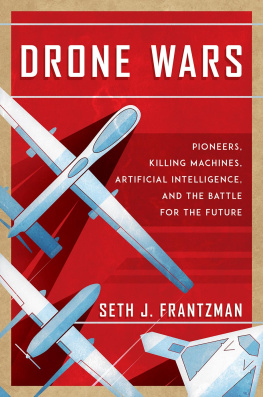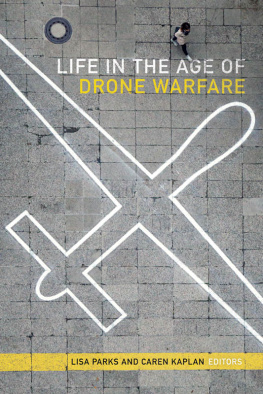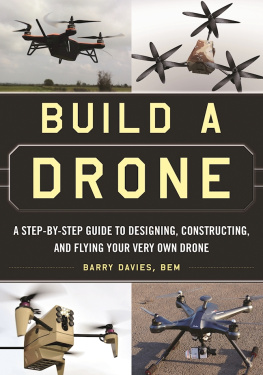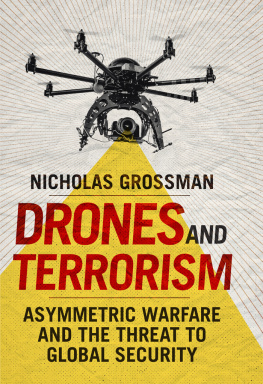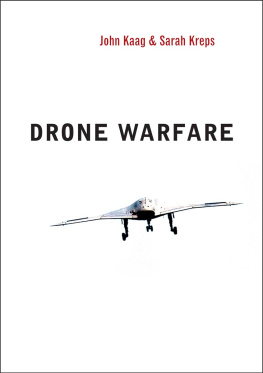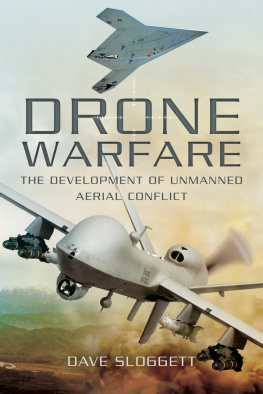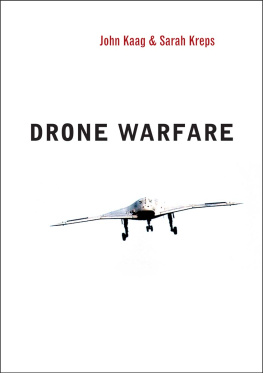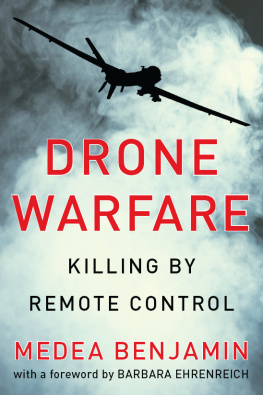Drone
Remote Control Warfare
Hugh Gusterson
The MIT Press
Cambridge, Massachusetts
London, England
2016 Massachusetts Institute of Technology
All rights reserved. No part of this book may be reproduced in any form by any electronic or mechanical means (including photocopying, recording, or information storage and retrieval) without permission in writing from the publisher.
This book was set in Stone Sans and Stone Serif by Toppan Best-set Premedia Limited. Printed and bound in the United States of America.
Library of Congress Cataloging-in-Publication Data
Names: Gusterson, Hugh.
Title: Drone : remote control warfare / Gusterson, Hugh.
Description: London, England : The MIT Press, [2015] | Includes bibliographical references and index.
Identifiers: LCCN 2015039936 | ISBN 9780262034678 (hardcover : alk. paper)
eISBN 9780262334358
Subjects: LCSH: Drone aircraftHistory. | Drone aircraftMoral and ethical aspects. | Drone aircraftSocial aspects. | Air warfareUnited StatesMoral and ethical aspects. | Air warfareUnited StatesHistory21st century.
Classification: LCC UG1242.D7 G88 2015 | DDC 358.4/14dc23 LC record available at http://lccn.loc.gov/2015039936
10987654321
For my daughter Sasha
May you be a warrior for peace
The drone upsets the available categories, to the point of rendering them inapplicable.
Gregoire Chamayou
Acknowledgments
This book was written when I spent a year at the Princeton Institute for Advanced Study. It is hard to imagine an environment that is more stimulating or more congenial to writing. Many colleagues at the Institute helped shaped my thinking, but six deserve special mentionDidier Fassin for his mentorship and remarkable breadth of knowledge and ideas; Joan Scott, who helped me think through the nature of remote intimacy; Michael Walzer, also writing on drones, whose questions forced me to think more deeply; Freeman Dyson, who, as smart as ever at ninety-one, is deeply committed to dialogue between the natural and social sciences and, for the founder of the company that makes the Predator and Reaper drones, is surprisingly skeptical of drone warfare; Richard Wilson, who in answer to a stray question over lunch about drones and the law, gave me an impromptu minilecture that provided the framework for my penultimate chapter; and Anver Emon, who was kind enough to review that chapter for legal accuracy and overall acuity.
Thanks also to Tom Boellstorff, Faye Ginsburg, and Michelle Murphy for productive suggestions about drones as a media technology and to old comrades from the Network of Concerned Anthropologistsparticularly Catherine Besteman, Greg Feldman, and David Pricefor being on the lookout for material for me. Katherine Chandler and John Cloud both helped improve my understanding of drone history.
This book was originally conceived as an elaboration of a chapter on the anthropology of drones that was written in response to an invitation from Matthew Evangelista and Henry Shue. My thanks to both of them for that invitation and their gentle insistence that I broaden my reading on the topic.
I tried out early versions of some of the arguments in this book in my regular column for the Bulletin of Atomic Scientists. A succession of editors thereJosh Schollmeyer, Mindy Kay Bricker, John Mecklin, Sasha Scoblic, and Elisabeth Eavesgave me the latitude to experiment outside the normal territory of the Bulletin and helped improve my expression.
As this book simmered in my mind, I gave presentations to several audiences, whose members provided helpful feedbackthe anthropology department at New York University, M. V. Ramanas series at Princetons Global Security Program, Marie Chevriers class at Rutgers University, a session at the International Studies Association organized by Stephen Schwartz, and refreshingly polyglot audiences at sessions organized by Greg Feldman at Simon Fraser University and Subrata Ghoshroy at the Left Forum.
Thanks also to Regula Noetzli for the kind gift of her negotiating skills, and Beth Clevenger for her editorial enthusiasm.
Finally, there is my family. Graham and Sasha were generous to let their father disappear to work on his book, and Jana Urbanova, our au pair, cheerfully stepped into the breach. My greatest gratitude goes to my wife, Allison Macfarlane. Not only did she read drafts of each chapter, but during the past year, I incurred such a childcare debt to her that we may need to have another child for me to repay it.
Institute for Advanced Study, Princeton, New Jersey
July 4, 2015
Drones 101
To the United States, a drone strike seems to have very little risk and very little pain. At the receiving end, it feels like war. Americans have got to understand that.
General Stanley McChrystal
Drone strikes generally take place on the edge of American public awareness. Although the United States has been using drones for what it calls targeted killings for over a decade, this was not formally acknowledged until a 2012 speech by Central Intelligence Agency (CIA) director John Brennan.
Most people by now have a picture in their minds eye of the drones themselves. The silver-gray planes have a signature bulbous nose and inverted V tail fins, while the planes lack of windows lends them an eerie air of sealed-off blindness ( Although the drones themselves have become an iconic image, media accounts of actual drone strikes are usually confined to a terse paragraph announcing that a strike took place, saying how many militants or al Qaeda members were killed, giving their names if they are known, and naming the faraway country where they died. An exception to this rule is a remarkably vivid account published in the New Yorker of a drone strike in Pakistan as seen from the CIA command center:

A Predator unmanned aircraft.
Source: https://en.wikipedia.org/wiki/General_Atomics_MQ-1_Predator#/media/File:MQ-1_Predator_unmanned_aircraft.jpg.
On August 5th, officials at the Central Intelligence Agency, in Langley, Virginia, watched a live video feed relaying closeup footage of one of the most wanted terrorists in Pakistan. Baitullah Mehsud, the leader of the Taliban in Pakistan, could be seen reclining on the rooftop of his father-in-laws house, in Zanghara, a hamlet in South Waziristan. It was a hot summer night, and he was joined outside by his wife and his uncle, a medic; at one point, the remarkably crisp images showed that Mehsud, who suffered from diabetes and a kidney ailment, was receiving an intravenous drip.
The video was being captured by the infrared camera of a Predator drone, a remotely controlled, unmanned plane that had been hovering, undetected, two miles or so above the house. Pakistans Interior Minister, A. Rehman Malik, told me recently that Mehsud was resting on his back. Malik, using his hands to make a picture frame, explained that the Predators targeters could see Mehsuds entire body, not just the top of his head. It was a perfect picture, Malik, who watched the videotape later, said. We used to see James Bond movies where he talked into his shoe or his watch. We thought it was a fairy tale. But this was fact! The image remained just as stable when the C.I.A. remotely launched two Hellfire missiles from the Predator. Authorities watched the fiery blast in real time. After the dust cloud dissipated, all that remained of Mehsud was a detached torso. Eleven others died: his wife, his father-in-law, his mother-in-law, a lieutenant, and seven bodyguards.
There are a number of striking features to this account, which is told from the point of view of the executioners. A technology that is almost magical gives its owners, who are looking on the scene from high in the sky, a godlike power over life and death. The observation of the scene is simultaneously intimate and remote. It is also deeply asymmetrical: Mehsud, unaware of his exposure, is watched by faraway drone operators who can see him as if close up, reclining on the roof of his house on a hot evening as his wife attends to his medical needs. They get to frame the picture while he does not even realize he is in it. Without warning, he is killed as if by a gods thunderbolt from the sky. Seen from Virginia, the drone strike is quick, clean, and bloodless. Mehsuds death is instant. Nor, described unambiguously as a terrorist, does he seem undeserving of death. Twelve people die altogether, but the narrative marks only Mehsuds death as significant. The other deaths are almost outside the frame. And in a way that amplifies the strange mix of distance and intimacy, the scene is mediated entirely through a single sensevision. The attack has no sound, smell, taste, or texture. And we are invited to experience it through a narrative of mastery and controlof the cool, righteous exercise of overwhelming power.

